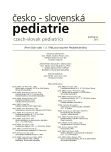Benign infantile seizures associated with noroviral gastroenteritis
Authors:
J. Melek 1; J. Malý 1; Š. Štefáčková 2; V. Štěpánová 3; P. Kosina 4; O. Pozler 1
Authors‘ workplace:
Dětská klinika LF a FN, Hradec Králové, přednosta prof. MUDr. M. Bayer, CSc.
1; Neurologická klinika Fakultní nemocnice, Hradec Králové, přednosta MUDr. R. Taláb, CSc.
2; Ústav klinické mikrobiologie Fakultní nemocnice, Hradec Králové, přednosta doc. RNDr. V. Buchta, CSc.
3; Klinika infekčních nemocí Fakultní nemocnice, Hradec Králové, přednosta doc. MUDr. S. Plíšek, Ph. D.
4
Published in:
Čes-slov Pediat 2012; 67 (3): 187-191.
Category:
Case Report
Overview
Case reports of two children with the case history of diarrhea disease followed by suddenly developed neurological symptomatology at the age of 15 and 17 months are described. The clinical, manifestations and examinations performed made it possible to establish the diagnosis of benign seizures associated with noroviral gastroenteritis.
Benign infantile seizures associated with noroviral gastroenteritis represent a relatively new unit described mainly in Asia. Noroviruses belong to the most frequent provoking agents. The disease affects so far healthy individuals at the age of 15–21 months. The main clinical manifestations include several although not many says lasting afebrile gastroenteritis, followed by seizure attacks, most often generalized tonic clonic seizures. The seizures tend to be rather recurrent in the first 24 hours and are rather resistant to anticonvulsant therapy. Noroviruses are often demonstrated in the stools. The basic biochemical parameters of serum, examination of liquor and imaging examination of the brain are often normal. Interictal EEG record may be normal or detecting abnormities which adjust in time. The prognosis despite apparently serious condition is usually excellent. The children further develop in a normal way and do not need anticonvulsant therapy.
Key words:
noroviruses, seizures, gastroenteritis, rotaviruses
Sources
1. Green KY. Caliciviridae: the noroviruses. In: Knipe DM, Howley PM, eds. Fields Virology. 5th ed. Philadelphia: Wolters Kluwer Health/Lippincott Williams and Wilkins; 2007, 949–979.
2. Zheng DP, Ando T, Fankhauser RL, et al. Norovirus classification and proposed strain nomenclature. Virology 2006; 346 : 312–323.
3. Koopmans M. Progress in understanding norovirus epidemiology. Curr Opin Infect Dis 2008; 21 : 544–552.
4. Chi-man VCH, Chun-wing DCH, Che-kwan M, Hin-biu CH. Norovirus as a cause of benign convulsion associated with gastro-enteritis. J Paed Child Health 2011; 47 (6): 373–377.
5. Chen SY, Tsai CN, Lai MW, et al. Norovirus infection as a cause of diarrhea-associated benign infantile seizures. Clin Infect Dis 2009; 48 : 849–855.
6. Kawano G, Oshige K, Syutou S, et al. Benign infantile convulsions associated with mild gastroenteritis: a retrospective study of 39 cases including virological tests and efficacy of anticonvulsants. Brain Dev 2007; 29 : 617–622.
7. Wallace SJ. Aetiologic aspects of febrile convulsions. Pregnancy and perinatal factors. Arch Dis Child 1972; 42 : 171–178.
8.Verrotti A, Nanni G, Agostinelli S, et al. Benign convulsions associated with mild gastroenteritis: A multicenter clinical study. Epilepsy Res 2011; 93 : 107–114.
9. Uemura N, Okumura A, Negoro T, Watanabe K. Clinical features of benign convulsions with mild gastroenteritis. Brain Dev 2002; 24 : 745–749.
10.Narchi H. Benign afebrile cluster convulsions with gastroenteritis: an observational study. BMC Pediatrics 2004; 4 : 1–4.
11. Kirby A, Gurgelb RQ, Dove W, et al. An evaluation of the RIDASCREEN and IDEIA enzyme immunoassays and the RIDAQUICK immunochromatographic test for the detection of norovirus in faecal specimens. J Clin Virol 2010; 49 : 254–257.
12. Medici CM, Abelli LA, Dodi I, et al. Norovirus RNA in the blood of a child with gastroenteritis and convulsions – A case report. I. J Clin Virol 2010; 48 : 147–149.
13. Takanashi S, Hashira S, Matsunaga T, et al. Detection, genetic characterization, and quantification of norovirus RNA from sera of children with gastroenteritis. J Clin Virol 2009; 44 : 161–163.
14. Ito S, Takeshita S, Nezu A, et al. Norovirus-associated encephalopathy. Pediatr Infect Dis J 2006; 25 : 651–652.
15. Verrotti A, Tocco AM, Coppola GG, et al. Afebrile benign convulsions with mild gastroenteritis: a new entity? Acta Neurol Scand 2009; 120 : 75–79.
16. Okumura A, Uemura N, Negoro T, Watanabe K. Efficacy of antiepileptic drugs in patients with benign convulsions with mild gastroenteritis. Brain Dev 2004; 26 : 164–167.
17. Abe T, Kobayashi M, Araki K, et al. Infantile convulsions with mild gastroenteritis. Brain Dev 2000; 22 : 301–306.
18. Obinata K, Okumura A, Nakazawa T, et al. Norovirus encephalopathy in a previously healthy child. Pediatr Infect Dis J 2010; 29; 1057–1058.
Labels
Neonatology Paediatrics General practitioner for children and adolescentsArticle was published in
Czech-Slovak Pediatrics

2012 Issue 3
- What Effect Can Be Expected from Limosilactobacillus reuteri in Mucositis and Peri-Implantitis?
- The Importance of Limosilactobacillus reuteri in Administration to Diabetics with Gingivitis
Most read in this issue
- Unusual manifestations of parvovirus B19 infection in children
- Pyruvate kinase deficiency in children
- Variability in clinical manifestation of noroviral infection in a newborn: from fulminant necrotizing enterocolitis to asymptomatic course
- Benign infantile seizures associated with noroviral gastroenteritis
